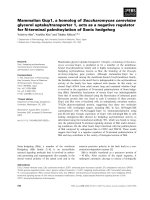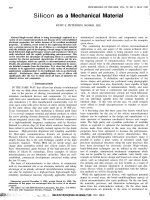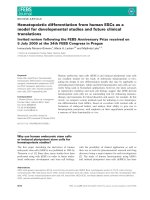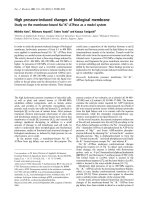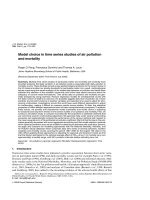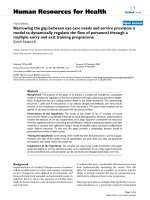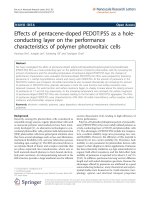- Trang chủ >>
- Khoa Học Tự Nhiên >>
- Vật lý
Silicon as a model ion trap: Time domain measurements of donor Rydberg states
Bạn đang xem bản rút gọn của tài liệu. Xem và tải ngay bản đầy đủ của tài liệu tại đây (439.38 KB, 5 trang )
Silicon as a model ion trap: Time domain
measurements of donor Rydberg states
N. Q. Vinh*, P. T. Greenland
†
, K. Litvinenko
‡
, B. Redlich*, A. F. G. van der Meer*, S. A. Lynch
†
, M. Warner
†
A. M. Stoneham
†
, G. Aeppli
†
, D. J. Paul
§
, C. R. Pidgeon
¶
and B. N. Murdin
‡ʈ
*FOM Institute for Plasma Physics Rijnhuizen, P.O. Box 1207, NL-3430 BE Nieuwegein, The Netherlands;
†
London Centre for Nanotechnology
and Department of Physics and Astronomy, University College London, London WC1H 0AH, England;
‡
Advanced Technology Institute,
University of Surrey, Guildford GU2 7XH, England;
§
Department of Electronics and Electrical Engineering, University of Glasgow,
Glasgow G12 8LT, Scotland; and
¶
Department of Physics, Heriot-Watt University Riccarton, Edinburgh EH14 4AS, Scotland
Edited by Manuel Cardona, Max Planck Institute for Solid State Research, Stuttgart, Germany, and approved May 27, 2008 (received for review
March 20, 2008)
One of the great successes of quantum physics is the description of
the long-lived Rydberg states of atoms and ions. The Bohr model
is equally applicable to donor impurity atoms in semiconductor
physics, where the conduction band corresponds to the vacuum,
and the loosely bound electron orbiting a singly charged core has
a hydrogen-like spectrum according to the usual Bohr–Sommerfeld
formula, shifted to the far-infrared because of the small effective
mass and high dielectric constant. Manipulation of Rydberg states
in free atoms and ions by single and multiphoton processes has
been tremendously productive since the development of pulsed
visible laser spectroscopy. The analogous manipulations have not
been conducted for donor impurities in silicon. Here, we use the
FELIX pulsed free electron laser to perform time-domain measure-
ments of the Rydberg state dynamics in phosphorus- and arsenic-
doped silicon and we have obtained lifetimes consistent with
frequency domain linewidths for isotopically purified silicon. This
implies that the dominant decoherence mechanism for excited
Rydberg states is lifetime broadening, just as for atoms in ion traps.
The experiments are important because they represent a step
toward coherent control and manipulation of atomic-like quantum
levels in the most common semiconductor and complement mag-
netic resonance experiments in the literature, which show extraor-
dinarily long spin lattice relaxation times—key to many well
known schemes for quantum computing qubits—for the same
impurities. Our results, taken together with the magnetic reso-
nance data and progress in precise placement of single impurities,
suggest that doped silicon, the basis for modern microelectronics,
is also a model ion trap.
coherence ͉ free electron laser ͉ quantum information ͉
picosecond population dynamics ͉ hydrogenic donor impurity
H
omogenous lifetime-broadened two-level atoms in ion traps
(1) have become favorite objects of study for quantum
optics with a view toward both fundamental physics and the
eventual development of a quantum computer. Among the many
schemes proposed (2), the states of ions in trap systems are
attractive for the realization of quantum information ‘‘qubits’’
(quantum bits) because they are well isolated from the deco-
hering effects of the environment and can be c oherently con-
trolled by lasers. The Bohr model is equally applicable to donor
impurit y atoms in semiconductor physics, where the conduction
band corresponds to the vacuum, and the loosely bound electron
orbiting a singly charged core has a hydrogen-like spectrum
ac cording to the usual Bohr–Sommerfeld formula, shifted to the
far-inf rared because of the small effective mass and high dielec-
tric constant. As with atoms in traps the ground states are tightly
c onfined and well isolated f rom the environment, giving rise to
extraordinarily sharp transitions (3–5) and ver y long spin coher-
ence times (6, 7), measured with magnetic resonance experi-
ments. There are several proposals for quantum information
processing based on the spin of silicon donors (8–13) and such
impurities can now be placed singly with atomic precision (14).
In one such scheme (10–13), a pair of bismuth impurities are
ent angled by optical pumping of an adjacent phosphorus atom,
strongly c oupled by the extended and nearly degenerate excited
st ates. For development of the impurity quantum coherence
physics and qubit applications it is crucial to establish time-
domain techn iques in the relevant frequency range given by the
Rydberg in silicon, which is Ϸ50 meV rather than 13.6 eV for
hydrogen. In particular, the lifetime T
1
and decoherence time T
2
of the e xcited state of the c ontrol impurity must be established,
because these set the maximum for the time separation, t
sep
,of
the gating pulses (see refs. 10–13 for details).
We report, for a Si:P Rydberg state, the first direct measure-
ments of T
1
that must, of necessit y, be perfor med in the time
domain. The required laser power, pulse duration, wavelength
c overage, and duty cycle for such measurements are ideally
matched to the parameters of the f ree-electron laser FELIX,
which gives continuous coverage of the spectral range 5–400
meV, controllable pulse durations of between 6 and 100 optical
c ycles, and peak powers of up to 100 MW.
In c ommon with spectroscopy of atoms in gases and traps,
f requency-domain spectroscopy of the excited states of impuri-
ties in semiconductors (see Fig. 1) has a long and distinguished
history (15–17). This remains an active field of research even
today, with particular attention given to the extraordinarily
narrow linewidths of some of the Rydberg transitions. In the
limit of a very clean, homogeneous material, frequency domain
spectrosc opy provides direct information about the relaxation
dynamics. For a real material, however, determination of relax-
ation times from the frequenc y domain linewidth is notoriously
dif ficult because the observed shape of the absorption line is
generally given by a convolution of the homogenous (or natural)
linewidth w ith the instrument response and a variety of inho-
mogenous broadening mechanisms. The latter include random
strain fields induced by impurities and/or dislocations (16, 17),
and other fluctuations in the donor environment caused by
chemical impurities and different isotopes in the natural com-
position of Si with differing nuclear moment (3–5). Time-domain
methods such as ours (18, 19) can directly measure the relaxation
without any convolution, but require a short-pulse laser, in our
case, a far-infrared f ree-electron laser. In addition, and much
more importantly for future work, these methods open up the
prospect of laser control of impurity states, in precise analogy
with the breakthrough that pulsed paramagnetic and nuclear
Author contributions: N.Q.V., G.A., D.J.P., C.R.P., and B.N.M. designed research; N.Q.V.,
P.T.G., K.L., B.R., A.F.G.v.d.M., S.A.L., and M.W. performed research; P.T.G. and A.M.S.
contributed new reagents/analytic tools; N.Q.V. and P.T.G. analyzed data; and P.T.G., G.A.,
C.R.P., and B.N.M. wrote the paper.
The authors declare no conflict of interest.
This article is a PNAS Direct Submission.
ʈ
To whom correspondence should be addressed. E-mail:
© 2008 by The National Academy of Sciences of the USA
www.pnas.org͞cgi͞doi͞10.1073͞pnas.0802721105 PNAS
͉
August 5, 2008
͉
vol. 105
͉
no. 31
͉
10649–10653
APPLIED PHYSICAL
SCIENCES
resonance techniques provide relative to continuous wave tech-
n iques for electron and nuclear spin resonance. Indeed, the only
other time-domain information available for impurities in silicon
c oncerns spin relaxation within the orbital ground state from
spin-echo experiments, which have recently been shown to
extend to 60 ms for isotopically pure Si:P (6). We therefore chose
to study the same donor species.
Transient Absorption Results
Fig. 2 shows the measured probe transmission change as a
function of time delay with respect to the pump pulse for the
1s(A
1
) 3 2p
0
transition at 34.1 meV in P-doped Si. The rise of
the leading edge indicates the pulse duration, which was 10 ps in
this case. For all pump powers, the decay is (almost) exponential;
the signal is (almost) linear when plotted on a log-linear scale.
Fits with a simple ex ponential decay gave a value for the lifetime
of T
1
ϭ 205 Ϯ 18 ps. This corresponds to a linewidth of 1/T
1
ϭ
0.026 cm
Ϫ1
, that is, less, but not very much less, than the lowest
value reported (3) for this transition of 0.034 cm
Ϫ1
, which was
obt ained in an isotopically pure
28
Si sample. Fig. 3 shows the
absorption spectrum and lifetimes for P-doped Si and As-doped
Si samples. The absorption spectrum was measured with a
resolution of 0.25 cm
Ϫ1
(0.03 meV) at 10 K. The well known
-20
-40
-50
-30
-10
-0
45.59
33.89
32.58
11.48
6.40
5.47
3.31
1s(T
2
)
2p
±
1s(A
1
)
1s(E)
2p
0
3p
0
4p
0
Optical
Optical
Optical
Forbidden
Forbidden
Optical
Optical
Energy (meV)
Si:P
34.11
39.19
40.12
42.28
43.40
13.01
11.70
+10
53.76
32.67
31.26
11.50
9.11
6.40
5.49
1s(T
2
)
2p
±
1s(A
1
)
1s(E)
2p
0
3p
0
2s
42.26
44.65
47.36
48.27
50.45
22.50
20.09
Si:As
-60
Optical
Optical
Optical
Forbidden
Forbidden
Optical
Optical
Fig. 1. Rydberg series and optical transitions from the lowest energy states of the hydrogen-like donor impurities phosphorus and arsenic in silicon (15, 16).
16.7 nJ
5.3 nJ
1.1 nJ
10
-1
10
-4
10
-3
10
-2
0 200 400 600 800
Delay between pump and probe pulses (ps)
Probe Transmission (arb. units)
pump
probe
Fig. 2. The change in probe transmission induced by the pump as a function
of the time delay between pump and probe, observed in the Si:P sample for
the 1s(A
1
) 3 2p
0
transition at a sample temperature, T, of 10 K and a pump and
probe photon energy of 34.1 meV. The rise of the leading edge indicates the
pulse duration, which was Ϸ10 ps. The laser pump powers used correspond to
the micropulse energies shown on the figure. The lowest pump pulse energy
(1.1 nJ) corresponds to a focused photon fluence of Ϸ10
17
photons m
Ϫ2
. Also
shown are fits using a single exponential decay where the decay parameter is
the spontaneous relaxation rate 1/T
1
.(Inset) Transient pump-probe experi-
mental geometry.
Si:P
Si:As
LA
LO
2p
0
2p
±
2p
0
2p
±
3p
±
3p
0
200
100
0
200
100
0
Phonon
DoS
Lifetime (ps)
Energy (meV)
30 40 50
Absorbance (arb. units)
Fig. 3. Population lifetime versus transition energy for transitions involving
the ground state. (Top) The absorption spectrum for P-doped Si measured by
FTIR spectroscopy with 0.25 cm
Ϫ1
or 0.03 meV resolution is shown. The sample
temperature was 10 K. The lifetimes of the indicated states, determined from
pump-probe signals (such as those in Fig. 2) are also shown. (Middle) The
corresponding results for Si:As. (Bottom) The one-phonon density of states
(DoS) including both longitudinal optical (LO) and longitudinal acoustical (LA)
modes of silicon, which, of course, determines thephononemissiondecayrate
at low temperature (taken from ref. 20).
10650
͉
www.pnas.org͞cgi͞doi͞10.1073͞pnas.0802721105 Vinh et al.
Ly man transitions 1s(A
1
) 3 np
0
, np
Ϯ
bet ween 34 and 45 meV are
apparent. No pump-probe effect was seen when the laser was not
resonant. The relaxation lifetime of the 2p
0
st ate in Si:P has the
longest lifetime because it is farthest from the peak in the density
of phonon states (20). The fact that the 2p
Ϯ
shows a slightly
shorter lifetime than the 2p
0
is also consistent with the spectro-
sc opic linewidth (3). The lifetime of the 2p
0
st ate in Si:As is
slightly shorter than that of Si:P but we note that, despite this
dif ference, Si:As is potentially more useful because the energy
gap between Rydberg states is larger and overlaps with the
available wavelength range of far-infrared semiconductor diode
laser pump sources.
Multiphoton Ionization
If we take the absorption cross-section for 1s(A
1
) 3 2p
0
to be
abs
ϳ 3 ϫ 10
Ϫ18
m
2
f rom the small-signal absorption spectr um, and
note that the Si transmission coef ficient is ⍜ Ϸ0.7, then the
lowest photon fluence (the number of photons per unit area
integrated over the pulse), F, used in Fig. 2 c orresponds to a
pumping probability of ⍜F
abs
ϳ 0.2, so the excitation densities
are small. Photoionization f rom the excited state is therefore
insign ificant. However, just as the Rydberg spectrum of the
silic on donor impurity is at a much smaller energy than for free
atoms, so the excited states are much closer to the continuum of
c onduction band states. The presence of strong multiphoton
ion ization processes that have produced a rich variet y of atomic
and molecular physics effects, but would interfere with qubit
operation, might therefore be expected at higher pump powers
relevant for strong-field limit effects such as Rabi oscillations.
The photon fluence required for a pulse area A ϭ
for
p
ϭ 10
ps is F ϳ 10
20
m
Ϫ2
. (The pulse area A ϭ
/ប͐E(t)dt, where
is
the dipole matrix element and E(t) is the electric field profile of
the pulse.) We take the photoionization cross-section from the
2p
0
st ate to be
ionize
Ϸ 5 ϫ 10
Ϫ21
m
2
, calculated by using the
hydrogen ic 2p 3 continuum photoionization cross-section (21),
appropriately scaled for the effective mass of Si:P. This results in
an ionization probability of ⍜F
ionize
ϳ 0.3 for the
p
ϭ 10 ps,
pulse so we might expect a small conduction electron popu-
lation in the strong field limit. We now show that this population
is unimportant.
We made measurements similar to those of Fig. 2 up to a
maximum fluence of 1.3 ϫ 10
20
m
Ϫ2
, shown in Fig. 4. In all cases
we find a decay indistinguishable from a single exponential with
the same decay time as in the low power limit. To understand this
remark ably simple result, we analyze the dynamics after the
pump pulse has passed, that is, the relaxation and the corre-
sponding recombination of free electrons and ions, with a simple
rate equation model (22). Three states are important: (i) the
ground state, 1s( A
1
), (ii) the state excited by the pump (2p
0
), and
(iii) the ionized state, with dimensionless occupation probabil-
ities n
g
, n
x
, and n
i
, respectively. Charge conservation implies that
the f ree-electron density is equal to the ion density and particle
c onservation implies n
g
ϩ n
x
ϩ n
i
ϭ 1. We have
n˙
g
ϭ n
x
͞T
1
ϩ P
g
n
i
2
n˙
x
ϭ Ϫn
x
/T
1
ϩ P
x
n
i
2
[1]
n˙
i
ϭ ϪP
tot
n
i
2
The first of these equations represents the feeding of the
ground st ate by decay f rom the excited st ate at rate 1/T
1
and
rec ombination of the electrons and ions w ith rate P
g
. This
rec ombination is proportional to the product of the electron
and ion densities, and therefore scales like n
i
2
. The other
equations are similarly interpreted, and P
tot
ϭ P
g
ϩ P
x
. P
x
describes relaxation between the c ontinuum and the excited
st ate which is important at elevated temperature (23). Eqs. 1
can be integrated analytically,**, but inspection shows that the
relaxation gives rise to ex ponentially decaying terms in the
excited population, whereas the recombination gives rise to
reciprocal (1/t, where t is the time af ter the pump pulse) decays.
The recombination rates are given by P
g,x
ϭ
recom
g,x
e
N
0
, where
recom
g,x
is the cross-section for electron capture to the g round
or excited st ate and
e
is the mean velocity of the electrons so
captured. The rec ombination time 1/P
tot
Ϸ 16 ps, which sets the
time scale for rec ombination under c omplete ionization, can
be found by t aking Brown’s value for the electron recombi-
nation cross-section
recom
ϳ 3 ϫ 10
Ϫ16
m
2
(24), and a mean
electron velocity
e
Ϸ 5.3 ϫ 10
4
ms
Ϫ1
appropriate for electrons
which have been two-photon ion ized. The probe absorption is
proportional to n
g
(t) Ϫ n
x
(t). It is clear from Eq. 1 that n˙
g
Ϫ
n˙
x
is unaffected by recombination of free electrons and ions in
the case that P
g
Ϸ P
x
, even if fast. In the case of asymmetric
rec ombination, a fast initial transient is expected, whereas the
**Eqs. 1 can be solved to give
n
g
͑t͒ ϭ n
g0
ϩ n
x0
͓1 Ϫ e
Ϫ
␥
t
͔ ϩ n
i0
͓a͑t͒ Ϫ b͑t͔͒
n
x
͑t͒ ϭ n
x0
e
Ϫ
␥
t
ϩ n
i0
b͑t͒
n
i
͑t͒ ϭ n
i0
͓1 Ϫ a͑t͔͒
where
␥
ϭ1/T
1
and
a͑t͒ ϭ
ͩ
t
t ϩ t
R
ͪ
b͑t͒ ϭ
ͩ
P
x
P
tot
ͪ
͕a͑t͒ ϩ e
Ϫ
␥
t
Ϫ 1 ϩ
␥
t
R
e
Ϫ
␥
͑
tϩt
R
͒
͓E
1
͑ Ϫ
␥
t
R
͒ Ϫ E
1
͑ Ϫ
␥
͑t ϩ t
R
͔͖͒͒
In thistreatment E
1
(z) isthe exponential integral
͵
z
ϱ
e
Ϫ1
t
dt, and t
R
ϭ [n
i0
P
tot
]
Ϫ1
is theinitial
ion recombination time. The quantities n
g0
, n
x0
, and n
i0
are the ground state, excited state,
and ion occupation probabilities produced by the pump pulse.
experiment
reciprocal fit
exponential fit
experiment
reciprocal fit
exponential fit
-1
-2
-3
-4
log
e
(T) (a.u.)
80
60
40
20
0
1 / T (a.u.)
Delay time (ps)
0 200 400 600 800
Fig. 4. The probe transmission at high pump intensity is shown as a function
of pump-probe delay, along with a fitted single exponential decay and a
reciprocal decay. We plot both the logarithm (Upper) and reciprocal (Lower)
of the signal. If spontaneous decay is most important, we expect the former to
be linear as a function of time; if recombination from the conduction band is
most important, then the latter will show linear behavior. At high intensities,
even though two-photon ionization is likely to be strong, the experimental
signal is exponential.
Vinh et al. PNAS
͉
August 5, 2008
͉
vol. 105
͉
no. 31
͉
10651
APPLIED PHYSICAL
SCIENCES
rest of the decay is then dominated by the 200-ps time scale
associated with the excited- to ground-state transition. We see
a negligible effect of electron-ion recombination on the probe
transmission decay, and no in itial fast transients, even at the
highest pump intensity used (Fig. 4). We c onclude that ion-
ization caused by multiphoton absorption during pumping is
un import ant for interpret ation of our ex periment, either
because we have overestimated its cross-section or because the
rec ombination is fast and symmetric.
Temperature Dependence
A key feature distinguishing silicon from ion traps is that there
is a bath of excitations, Si lattice phonons, coupled to the donor
levels. Warming will increase the population of the bath, even-
tually causing depopulation and decoherence. To quantify this
ef fect and determine the temperature range over which Si can
mean ingfully function as an ion trap, we have measured the
temperature dependence of the 2p
0
and 2p
Ϯ
3 1s(A
1
) decay
times. Fig. 5 shows the remarkable result that the decay times
actually increase with temperature—more obviously for 2p
Ϯ
than for 2p
0
—displaying a maximum at 50 K. We explain this
temperature dependence with a phenomenological equation for
the effective relaxation time (25):
1
eff
͑T͒
ϭ
1
T
1
Ϫ R
a
e
Ϫ⌬E
a
/kT
ϩ R
b
e
Ϫ⌬E
b
/kT
[2]
The first term on the right describes the direct population
relaxation from 2p
0
to 1s(A
1
). The second term, given earlier for
ion ized acceptors by Cuthbert (25), comes about because raising
the temperature increases the number of equilibrium free elec-
trons. The upshot is an increased effective lifetime as measured
in our absorption experiment, which senses a recovery of the
1s 3 2p
0
signal only when the 1s state is reoccupied, which is, of
c ourse, less likely when the original electrons are far from the
donors. At higher temperatures the Boltzmann tail of the
f ree-electron distribution can have enough energy to enable
ther mal excitation sufficiently far into the conduction band for
subsequent recombination v ia emission of the strong transverse
optical phonon, energy E
TO
Ϸ 60 meV. This gives rise to the third
ter m. At the same time, of course, the Saha equation (26)
predicts that the equilibrium density of the ground state disap-
pears on a similar energy scale that is much smaller than that
(Ϸ10,000 K) for hydrogen.
The Fig. 5 Inset illustrates the effects described above, and
shows how the adjustable parameters of Eq. 2 can be interpreted:
⌬E
a
is the ionization energy for 2p electrons, ⌬E
b
ϭ E
TO
Ϫ E
21
is the energy required to activate the 2p electrons to a state from
which they may decay to the 1s(A
1
) g round state by optical
phonon emission; 1/R
b
ϭ 1/R
TO
is the optical phonon emission
lifetime and E
21
is the energy of 2p 3 1s(A
1
) transitions. The
solid line in Fig. 5 corresponds to the following values of the
fitting parameters: T
1
ϭ 215 Ϯ 10 ps, ⌬E
a
ϭ 11.8 Ϯ 1.1 meV,
⌬E
b
ϭ 32.1 Ϯ 2.1 meV, and 1/R
b
ϭ 1.7 ps. The energy values for
the excited state and the ground state involved in the relaxation
process for the 2p
0
3 1s(A
1
) transition are in good agreement
with E
a
ϭ 11.5 meV, E
TO
Ϫ E
21
Ϸ 30 meV. The lifetime of 215
ps is also close to the 205 ps found above. The temperature
dependence of the lifetime of the 2p
Ϯ
is similar to that of the 2p
0
because the transition energy is similar, although the ionization
energy is smaller by a factor of two, giv ing rise to the steeper
in itial increase. Numerical solution of the rate equations to finite
temperature, including statistical detailed balance, confirms our
interpret ation. We remark that, even though recombination is an
import ant process at higher temperature, the probe transmission
still shows an approx imately exponential time dependence. It is
also worth noting that the agreement of the simple model above
with the data again indicates that multiphoton ionization by the
pump is unimportant for our results.
Conclusions
In summary, we have shown that impurities in Si share
sign ificant virtues w ith isolated atoms in traps, although
phonon, rather than photon emission leads to decay time scales
10–100 times faster than what is usual in atoms. Our time-
domain dat a show directly that population decay ef fects are
the dominant contribution to frequenc y-domain linewidths of
Rydberg levels in isotopically pure silic on. Comparing with
linew idths from the f requency domain, we find that, at low
temperature in isotopically purified material, the dominant
dec oherence mechan ism is lifetime broaden ing because of the
emission of phonons. The donors can be ef fectively isolated
f rom the environment and have no sign ificant sources of
dec oherence other than population decay by emission of
phonons. In addition, we show remarkable insensitivit y of the
results to multiphoton ef fects as we vary the power of the
intense free-electron laser beam, and discover that initially
the rec overy time for 2p 3 1s absorption actually increases
w ith temperature. Finally, T
1
is six times the Lar mor preces-
sion period for the g ϭ 2 impurity spins in Si at the modest
external field of 1 T, implying the possibility of programming
sequences of spin and Rydberg st ate operations on impurities
in the world’s best understood material, as required for
proposed quantum qubit schemes (10–13).
Experimental Procedures
We performed a pump-probe measurement of the lifetimes for different
photon energies resonant with transitions between the silicon impurity Ryd-
berg states by using the FELIX free-electron laser at the FOM Institute for
Plasma Physics ‘‘Rijnhuizen,’’ Nieuwegein, The Netherlands. In this technique,
described in detail elsewhere, a strong pump pulse causes bleaching of the
absorption measured by the weak probe pulse, the recovery of which is then
measured as a function of the delay between the two (18, 19). The samples
investigated were float-zone-grown Si wafers of thickness Ϸ200
m and
doped with P or As to donor concentrations of N
0
ϳ 2 ϫ 10
21
m
Ϫ3
. The silicon
was ‘‘natural,’’ that is, not isotopically purified.
ACKNOWLEDGMENTS. We thank Engineering and Physical Sciences Research
Council (EPSRC) and the Stichting voor Fundamenteel Onderzoek der Materie
(FOM) for providing the required beam time on FELIX. This work was sup-
ported by the European Union grant IST-2001-38035, EPSRC Grant GR/S23506,
EPSRC Advanced Fellowship EP/E061265/1, the Basic Technologies Program of
EPSRC, and the Royal Society Wolfson Research Merit Award Scheme.
Lifetime (ps)
Temperature (K)
0 50 100
0
100
200
∆E
b
E
TO
∆E
a
2p
0
1s(A
1
)
R
a
R
TO
1/ T
1
E
21
Si:P
2p
0
2p
±
Fig. 5. The temperature dependence of the lifetimes for 1s(A
1
) 3 2p
0
,2p
Ϯ
transitions at 34.1 and 39.2 meV, respectively, in P-doped Si. The lines are fits
of Eq. 2.(Inset) Level scheme with transitions.
10652
͉
www.pnas.org͞cgi͞doi͞10.1073͞pnas.0802721105 Vinh et al.
1. Paul W (1990) Electromagnetic traps for charged and neutral particles. Rev Mod Phys
62(3):531–540.
2. Gulde S, et al. (2003) Implementation of the Deutsch-Jozsa algorithm on an ion-trap
quantum computer. Nature 421(48):48–50.
3. Karaiskaj D, Stotz JAH, Meyer T, Thewalt MLW, Cardona M (2003) Impurity absorption
spectroscopy in
28
Si: The importance of inhomogeneous isotope broadening. Phys Rev
Lett 90(18):186402-1.
4. Yang A, et al. (2006) Optical detection and ionization of donors in specific electronic
and nuclear spin states. Phys Rev Lett 97:227401.
5. Thewalt MLW, et al. (2007) Direct observation of the donor nuclear spin in a near-gap
bound exciton transition:
31
P in highly enriched
28
Si. J Appl Phys 101:081724.
6. Tyryshkin AM, Lyon SA, Astashkin AV, Raitsimring AM (2003) Electron spin relaxation
times of phosphorus donors in silicon. Phys Rev B 68(19):193207.
7. Tahan C, Friesen M, Joynt R (2002) Decoherence of electron spin qubits in Si-based
quantum computers. Phys Rev B 66(3):035314.
8. Kane BE (1998) A silicon-based nuclear spin quantum computer. Nature 393:133–
137.
9. Vrijen R, et al. (2000) Electron-spin-resonance transistors for quantum computing in
silicon-germanium heterostructures. Phys Rev A 62(1):012306.
10. Stoneham AM, Fisher AJ, Greenland PT (2003) Optically driven silicon-based quantum
gates with potential for high-temperature operation. J Phys Condens Matter
15(27):L447.
11. Rodriquez R, Fisher AJ, Greenland PT, Stoneham AM (2004) Avoiding entanglement
loss when two-qubit quantum gates are controlled by electronic excitation. J Phys
Condens Matter 16(28):2757–2772.
12. Kerridge A, Savory S, Harker AH, Stoneham AM (2006) Time dependent quantum
simulations of two-qubit gates based on donor states in silicon. J Phys Condens Matter
18(21):S767–S776.
13. Savory S (2006) Disentangling the control electron in a two qubit solid state quantum
gate. J Phys Condens Matter 18(21):S777–S782.
14. Ruess FJ, et al. (2004) Towards atomic-scale device fabrication in silicon using scanning
probe microscopy. Nanoletters 4:1969.
15. Yu PY, Cardona M (2001) Fundamentals of Semiconductors (Springer, New York), 3rd
Ed.
16. Ramdas AK, Rodriguez S (1981) Spectroscopy of the solid-state analogues of the hydrogen
atom: Donors and acceptors in semiconductors. Rep Prog Phys 44:1297–1387.
17. Jagannath C, Grabowski ZW, Ramdas AK (1981) Linewidths of the electronic spectra of
donors in silicon. Phys Rev B 23(5):2082–2098.
18. Findlay PC, et al. (1998) Auger recombination dynamics of lead salts under picosecond
free-electron-laser excitation. Phys Rev B 58(19):12908 –12915.
19. Halsall MP, Harrison P, Wells J-PR, Bradley IV, Pellemans H (2001) Picosecond far-
infrared studies of intra-acceptor dynamics in bulk GaAs and
␦
-doped AlAs/GaAs
quantum wells. Phys Rev B 63(15):155314.
20. Flensburg C, Stewart RF (1999) Lattice dynamical Debye-Waller factor for silicon. Phys
Rev B 60(1):284 –291.
21. Bethe HA, Salpeter EE (1957) Quantum Mechanics of One- and Two-Electron Atoms
(Springer, New York).
22. Lohner A, Woerner M, Elsaesser T, Kaiser W (1992) Picosecond capture of photoexcited
holes by shallow acceptors in p-type GaAs. Phys Rev Lett 68(26):3920 –3923.
23. Nishikawa K, Barrie R, (1963) Phonon broadening of impurity spectral lines: II. Appli-
cation to silicon. Can J Phys 41:1823.
24. Brown RA (1966) Effect of impurity conduction on electron recombination in germa-
nium and silicon at low temperatures. Phys Rev 148(2):974 –981.
25. Cuthbert JD, Thomas DG (1966) Fluorescent decay times of excitons bound to isoelec-
tronic traps in GaP and ZnTe. Phys Rev B 154(3):763–771.
26. von Engel A (1994) Ionized Gases AIP Press, Woodbury, NY, Chap 3, p 82.
Vinh et al. PNAS
͉
August 5, 2008
͉
vol. 105
͉
no. 31
͉
10653
APPLIED PHYSICAL
SCIENCES
